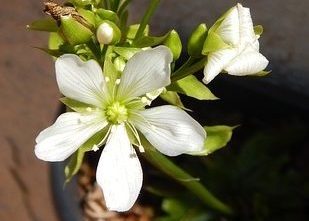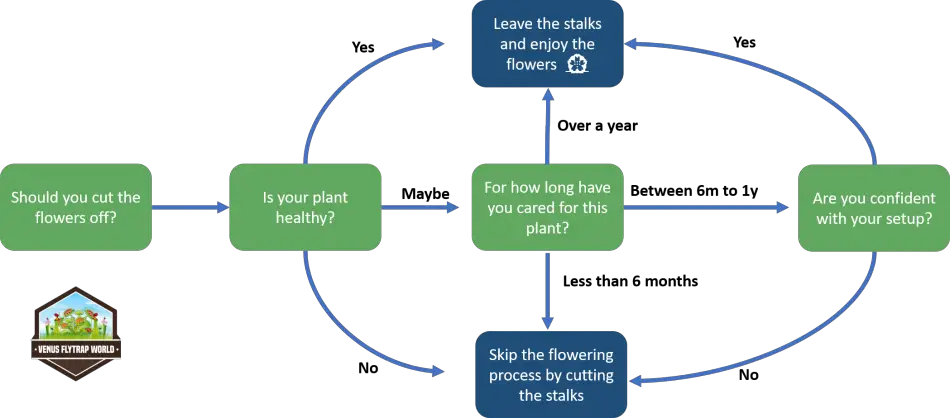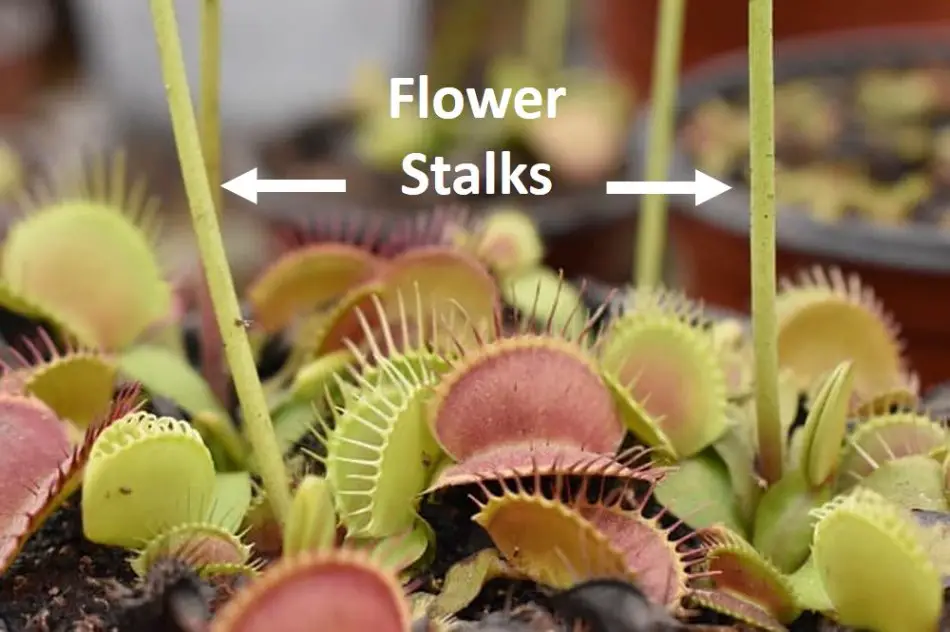Is your Venus flytrap flowering? This article will give you all the details you need to know about the Venus flytrap flowering process.
After reaching maturity, Venus flytraps flower every spring. They produce flower stalks that turn into flower bunches with white petals and green veins. The flowering process drains energy from the plant to focus on reproduction.
The flowering process of Venus flytraps is entirely normal. However, as a new Venus flytrap grower, you should decide if proceeding with the flowering cycle is the right choice. Also, you might be interested in propagating your plant with seeds or through flower stalks. Keep on reading for more information.
If you want to learn exactly what does it really mean when your Venus flytrap flowers, you can read this article.
The Venus Flytrap Flowering Process
Once a Venus flytrap has reached maturity, usually at about 2-4 years old, it will start producing flowers. Venus flytraps produce flowers during the spring. Usually not too far apart from exiting dormancy.
Venus flytraps produce thick cylindrical structures that are flower stalks. The flower stalks extend to be a lot taller than the traps and eventually turn into flower bunches.

The flowers are not particularly impressive, but they are pretty. They are white and have green veins running through the petals. Observing a Venus flytrap during flowering is unique. Usually most people are just looking to see the traps. Many are impressed when they discover Venus flytraps also produce flowers.
When a Venus flytrap flowers, it produces several flower stalks. Not all at the same time, but through the same period.
Special Care During Flowering
Some Venus flytrap owners have the misconception that Venus flytrap need special care during the flowering process. During the flowering season, there are no additional care instructions. Just continue to care for your plant as you have been doing. The plant might slow down its growth to focus on reproduction, but it should not show signs of struggle.
Should I Cut the Venus Flytrap Flowers Off?
It is a general suggestion to cut the flower stalks off your plant before they grow completely to prevent the flowering process. In this section, I will give you some background information to help you decide if you should cut the flowers off your Venus fly trap. Also, this decision tree can help you:

Does the Flowering Process Kill Venus Flytrap?
Novice growers sometimes believe the flowering process can kill Venus flytraps. However, this assumption is not true.
When a Venus flytrap produces flowers, it spends substantial amounts of energy to focus on reproduction. The flowering process does not kill or harm Venus flytraps. It just drains energy that can be used for other purposes, such as general growth.
When to Stop the Flowering Process
You should cut off the flower stalks before flowering is complete if your plant is weak. Weak or sick Venus flytraps might not withstand going through the whole flowering process. For example, if your plant is recovering from a pest infestation or root rot, it might not be the best time to undergo flowering.
Healthy Venus flytraps produce flowers during the spring, and they continue to thrive through the later seasons. There is no need to skip the flowering process if you are confident your plant is in a good state. When you have kept a plant alive for 1 (or even 2+ years), you have already passed the test. Many people buy carnivorous plants without doing any research, and they end up killing them within weeks.
Suppose you are still unsure of the state of your plant. Read this article and review the care considerations. It will help you assess if you are following proper instructions when caring for your Venus flytrap.
Also, this article has a video and steps on how to remove the flower without harming the plant: Easy Steps to Remove Venus Fly Trap flowers.
Is It Ever Too Late to Remove the Stalks?
Sometimes it doesn’t make sense to remove the flower stalks anymore. As most of the process is complete and the plant has already used most of the energy allocated for reproduction. When the flower stalk has already produced a flower bud, it is too late. You can still cut it off and avoid some of the energy drainages of the flowering process. But it won’t make too much of a difference. Or, just let the buds flower and get some fantastic views and pictures of your plant with the flowers.
How to Cut the Venus Flytrap Flowers Off
Do you believe stopping the flowering process is necessary? If the answer is yes, then continue reading to learn how to remove the flowers.
The sooner you remove the flower stalks, the better. Do not wait until they grow tall. Instead, chop them off as quickly as possible. It is easy to identify the flower stalks within the plant due to their shape.

Once you have identified the flower stalk, use a pair of scissors to chop off the stalks from the very bottom. Remove as much of the stem as possible without harming the surrounding leaves of the center bulb. Then, dispose of the flower stalks or attempt to propagate your plant through stalk propagation.
Read the later section for more information on flower stalk propagation!
Venus flytraps produce multiple flower stalks through the season. Keep an eye on your plant for a couple of weeks. Some new flower stalks might start spurring.
What to Do With Venus Flytrap Flowers
Observing a Venus flytrap flower for the first time is exciting. But beyond just watching the flowers, you have the opportunity to propagate your plant. Through the methods below, you will be able to get more Venus flytraps with just a little bit of work.
Harvest Flytrap Seeds
You can harvest seeds from Venus flytraps, even when you have a single plant. In the wild, pollinators play a crucial role in seed production. To harvest seeds from your plant, you will act as a pollinator.
Pollination Instructions
- Let the Venus flytrap flower. The more flower bunches, the better.
- Gather a suitable tool for pollinators. Small paintbrushes or q-tips are appropriate.
- Observe a flower and identify the anther and the stigma. The anther holds the pollen. And the stigma is where the pollen germinates.
- Employ the q-tip or paintbrush to transfer the pollen from the anther to the stigma.
- After pollinating one flower, continue with the rest. It will increase your chances of success.
- Wait a few days to confirm the pollination was successful.
After pollinating, the fertilized flower will exhibit some changes. In the first couple of days, nothing might happen. But after, the flowers will start to dry up and die. This is normal! Just let it wither. Once the flower has dried up, it will leave capsules full of seeds. And you can get multiple seeds from each fertilized flower.
Now, it is time to collect the seeds. Carefully remove the flower remains and open it up to collect the seeds. Preferably, do it indoors. The seeds for Venus flytraps are tiny. Some light breeze can make you lose those seeds. Also, some people use a small Ziploc bag to support the area and prevent any seeds from getting lost or flying away.
The process of pollinating a plant with its own pollen is called self-pollination. Such an approach will produce good seeds. However, cross-pollination tends to make better specimens. Suppose you have more than one Venus flytrap in your home. Consider pollinating one with the pollen of the other.
The Seeds: Storage and Sowing
Now that you have the seeds, you can go ahead and start producing Venus flytrap seedlings. The process is simple:
- Gather a spacious container with drainage. Also, get a tray to go under the container.
- Fill it with carnivorous plant soil and saturated with distilled water. Here is a link to carnivorous plant soil you can use.
- Add a weak fungicide to prevent fungus outbreaks.
- Sow the seeds in the carnivorous plant soil. Sprinkle them around and separate them if possible.
- Press the seeds lightly towards the ground.
- Fill out the tray with distilled water to keep the environment moist.
- Keep the seeds at room temperature with access to sunlight and a humid medium.
- Venus flytrap seeds germinate in 6-8 weeks after sowing.
Also, you do not have to sow the seeds right away. You can wait to sow them in the next week or month. However, if you plan on storing them for a few months, place them under refrigeration.
Venus Flytrap Flower Stalk Propagation
Besides growing Venus flytraps from seeds, you can propagate these plants through stalk propagation. It is possible to attempt this method even if the plant has not flowered. But, the flower stalks have to grow to be successful at stalk propagation.
These are the instructions for Venus flytrap stalk propagation:
- Find a plastic or glazed ceramic pot with drainage. Also, gather a tray or plate to place under the pot.
- Make some carnivorous plant soil with proper aeration and drainage. For example, a 2:1 ratio of peat moss and perlite is a common and effective choice.
- Add distilled water to the soil until it has completely saturated with water.
- Place the humid soil in the pot.
- Add distilled water to the water plate and place the pot right on top. We will be watering this pot from the bottom and keeping a constantly humid environment.
- Wait until the stalks have grown a reasonable size. You can wait until then produce flower buds or when they are midway through growing.
- Use sharp scissors and cut the flower stalk. Cut the stems from as close to the bulb as possible. And cut off the flower bud (if applicable)
- Grab the flower stalk and cut it into smaller sections. For example, a 3-inch stalk cutting is a reasonable size.
- Now, you have two options. Place the cutting vertically and burry half an inch of the stalk underground with the rest sticking out. Or place the stalk cuttings horizontal to the ground and press it against the ground without burying it. Then, push some of the soil to cover the ends of the stalk.
You are all set. Continue to keep the environment humid and place under sunlight. The stalks cuttings start generating roots after a few weeks. Be patient and monitor the progression.
Curious Fact About The Flowers in Venus Flytraps
The Venus flytrap is a unique plant. Its trapping mechanism is one of the most complex ones observed in the plant kingdom. Also, the closing motion of its traps is swift compared to other plant motion. But, not all of its adaptations are focused on the leaves or the trapping mechanism. The flowers have also adapted to provide maximum efficiency.
Have you ever wondered how do Venus flytrap flowers get pollinated? Venus flytrap capture and consume bugs, which are usually the most successful pollinator. Do they rely solely on the wind or rain for pollination? Here is the distinctive explanation:
When you observe a Venus flytrap during the flowering process, you will notice that the traps grow 4-5 inches in length, but the flowers surpass the traps by a considerable height difference. The flowers sit on top, and the leaves stay close to the ground.
The Venus flytrap has evolved to separate its flowers from its leaves to avoid consuming pollinators. The plant keeps pollinators and food at two different levels. This is just another fascinating adaptation of the Venus flytrap.
Recommended Products for Growing Carnivorous Plants
Finding the best pots, lights, and soil for carnivorous plants is difficult. I have grown carnivorous plants for over 5 years, and these are the products I use. The links will take you to Amazon to view the prices and full specs:
- Carnivorous Plant Soil
- Carnivorous plant soil: https://amzn.to/422yLZa
- Artificial Lighting
- Small plant light for 1-2 plants: https://amzn.to/3oQsmSj
- T8 LED light fixture for multiple plants (6500k Cool White): https://amzn.to/3uWoeh2
- Pots and Miscellaneus
- Nursery pots for single plants: https://amzn.to/3oL8YGq
- TDS meter to measure water quality: https://amzn.to/3g8VKLI
- Dried crickets to feed carnivorous plants: https://amzn.to/34QEnKv
Related Questions
Why would a Venus Fly Trap flower in the winter?
Venus flytraps usually flower in the spring. However, they can bloom in any season when the conditions are not similar to their natural habitat. For example, when grown indoors without dormancy, some Venus flytrap flower during the winter. Follow this link to learn more about the dormant period.. Follow this link to learn more about the dormant period.. Also, some plants might produce flowers in unusual times due to sudden changes. For example, when a plant is transported to a different hemisphere, its seasonal clock might be off by a few months.
What do the flowers mean in Venus flytraps?
Venus flytraps only produce flowers when they have reached maturity. It takes the plant 3-4 years to achieve maturity. Then, they produce flowers every single year. The flowers are not a sign of health but a signal the plant is ready to start reproductive functions.
Why do Venus flytrap flowers turn black?
Venus flytrap flowers wither due to two reasons: successful pollination or age. However, the fertilized flower leave seeds behind as they turn black.

